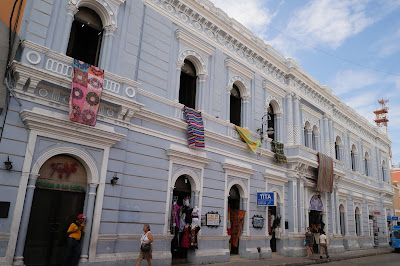Mérida was founded in 1542 by the Spanish Conquistador Francisco de Montejo (the Younger). It was built on the site of a Mayan city called T'ho. T'ho had been built of lime mortared stone and this reminded the Conquistadores of Merida in their native Spain that they named their new city after it. Some of the Mayan stones were used to build the cathedral and the other grand buildings around the main square.
We set out from our hotel near the junction of Calle 62 and Calle 49. Mérida has a grid pattern street layout like New York, but rather than a criss-cross of Streets and Avenues like New York, it has a criss-cross of odd numbered and even numbered Streets (a street is a Calle). It feels odd, but it is easy enough to get your head around after a while.
We were expecting Spanish Colonial style architecture and quite quickly we start to realise that a key feature would be beautiful pastel colours with pure white mouldings around doors and windows. This was the building next door ...
Further on as we headed south we enjoyed this hotel, the ground floor which seemed to belong to a cinema.
Soon after, we reached the astonishing art deco Armando Mazonero Theatre. It dates, slightly surprisingly, from 1949 (i.e. after the art deco era in Europe and North America).
The lobby has some nice features, but the auditorium is simply fantastic. It was renovated in 2000.
Shortly afterwards we reached the Plaza Grande. It is surrounded all sides by imposing buildings, mainly dating from soon after the founding of the city. The first thing that caught our eye was actually the modern Centro Cultural Olympico. On the outside it has been designed to harmonise with other buildings around the square which mostly have arcades at ground level (apparently plans for an ultra-modern exterior were rejected), but inside the rectangular exterior is a fine circular space. The centre is used for music and dance performances and exhibitions.
Continuing along the right side of the square is the splendid Palacio Municipal, built in 1542 and renovated in the 1730s and 1850s. The double row of arcades is very impressive.
On the South side of the square is the finest building in Mérida: the Casa Montejo, the mansion was built in 1549 initially as a barracks, but soon became Montejo's home. Astonishingly, his descendants lived there until 1970. The irregular façade with its elaborate gateway is fantastic (see the photo at the head of this post).
Inside, it is calm a peaceful, even though part of the building is now a bank.
We paused here. The remainder of our circular walk around the centre of Mérida is contained in my blog on Plaza Grande, Calle 60 and Paseo de Montejo.
Conditions: hot and sunny.
Distance: not much more than a mile.
Rating: Five stars. I have never really seen anything like it.
Conditions: hot and sunny.
Distance: not much more than a mile.
Rating: Five stars. I have never really seen anything like it.












No comments:
Post a Comment